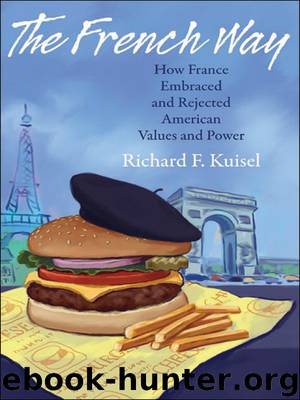The French Way by Kuisel Richard F

Author:Kuisel, Richard F.
Language: eng
Format: epub
Publisher: Princeton University Press
Trade Warriors
Trade, which in theory and practice bridged the Atlantic, also contributed, like security, to rancor in the United States and France. Trouble peaked in the early 1990s over the negotiations of the Uruguay Round of talks on the General Agreement on Tariffs and Trade (GATT).
President Bush, it has been said, spent more time during 1991 on the Uruguay Round than any other foreign policy problem except for the Gulf War and the Russians. Fear of a breakdown of trade negotiations overlapped with concerns about the European Community's effort at launching a unified market through the Single European Act as well as with transatlantic security issues especially building a new architecture around NATO. All of these projects interacted and seemed to focus on France. Bush officials, according to one insider, worried that the Europeans, led by the French, were ganging up on the Americans and wanted to shut them out, both economically and politically, forcing them to deal with “a Europe that was protectionist, exclusivist, inward-looking and difficult to deal with.”106
In designing a new Europe, American links with NATO took priority for Washington, but the project of a single market complicated matters. At first the Bush team, despite lingering anxiety about a coming “Fortress Europe,” supported, much more explicitly than had the Reagan White House, the advance of the European Community (EC). At Boston University's commencement in 1989, where both he and Francois Mitterrand received honorary degrees, President Bush endorsed the Single European Act, declaring that, despite the apprehension of some Americans, “a strong, united Europe means a strong America.”107 The White House was less worried about a “Fortress Europe” than were the U.S. Congress and the business community. Trade experts in the Bush administrations like Robert Zoellick believed that openly backing integration was the best way for the United States to retain some influence within a remodeled and strengthened EC.108 And Jacques Delors, the European Commission's president, helped allay fears by visiting the United States and dismissing nervousness about a pending rivalry between the Americans and the EC. Yet uneasiness about “Fortress Europe” persisted. In 1990 Zoellick raised the question ofwhether the new Europe would be “insular, itinerant, or international”—that is, whether it would be protectionist, an independent force, or a true partner with the United States.109 Then the brutal negotiations over the GATT, along with quarrels over NATO reform—in both cases Paris acted as the principal protagonist—intensified Washington's concern about an inward looking Europe that would discriminate against American interests. In a speech in the Netherlands shortly before the EC summit at Maastricht in late 1991 President Bush warned that “we must guard against the danger that old cold war allies will become new economic adversaries, cold warriors to trade warriors. There are signs on both sides of the Atlantic frankly, that this could happen.”110
In late 1992 French farmers torched the Stars and Stripes in front of the American embassy in Paris and stirred the ashes with pitchforks. Others blocked highways with their trucks and burned tires on railroad tracks.
Download
This site does not store any files on its server. We only index and link to content provided by other sites. Please contact the content providers to delete copyright contents if any and email us, we'll remove relevant links or contents immediately.
| Arms Control | Diplomacy |
| Security | Trades & Tariffs |
| Treaties | African |
| Asian | Australian & Oceanian |
| Canadian | Caribbean & Latin American |
| European | Middle Eastern |
| Russian & Former Soviet Union |
The Secret History by Donna Tartt(18951)
The Social Justice Warrior Handbook by Lisa De Pasquale(12170)
Thirteen Reasons Why by Jay Asher(8849)
This Is How You Lose Her by Junot Diaz(6837)
Weapons of Math Destruction by Cathy O'Neil(6220)
Zero to One by Peter Thiel(5736)
Beartown by Fredrik Backman(5682)
The Myth of the Strong Leader by Archie Brown(5463)
The Fire Next Time by James Baldwin(5386)
How Democracies Die by Steven Levitsky & Daniel Ziblatt(5175)
Promise Me, Dad by Joe Biden(5117)
Stone's Rules by Roger Stone(5053)
A Higher Loyalty: Truth, Lies, and Leadership by James Comey(4909)
100 Deadly Skills by Clint Emerson(4882)
Rise and Kill First by Ronen Bergman(4741)
Secrecy World by Jake Bernstein(4703)
The David Icke Guide to the Global Conspiracy (and how to end it) by David Icke(4659)
The Farm by Tom Rob Smith(4468)
The Doomsday Machine by Daniel Ellsberg(4452)
